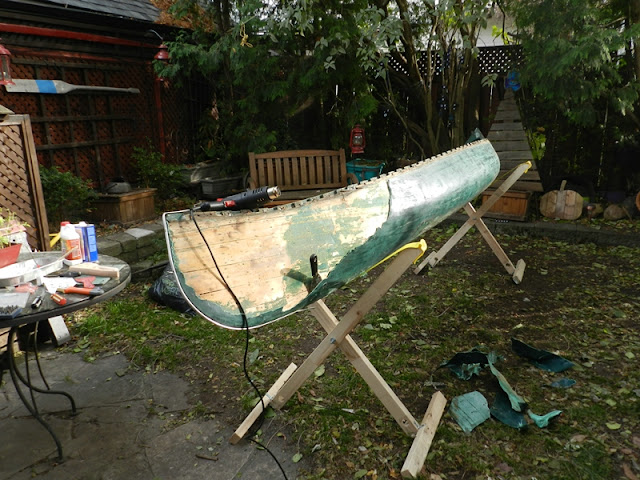Luckily, this canoe's experiment with fibreglass happened in the 1960's when polyester resins were used in the process. This meant that over time the glass would become more brittle and could (in theory) be easily removed by applying heat to soften the structure. Apparently epoxy resins used since the 80s are much more adhesive and stick aggressively to the planking making removal much more labour intensive if not impossible.
 |
Over the course of a few days, I was able to use a 1500W gun and start removing the impregnated cloth. Videos I've seen online often show the glass easily coming off without leaving any resin remnants on the hull. This canoe was not so forgiving. It seems the application by the original owner was quite uneven and large sections of the hull left pockets of green-coloured resin in a weave pattern once the cloth itself was removed.
Here is a shot of the final bits of fibreglass covering coming off the other side of the hull. Plenty of resin left over meant that I had to go over it again with the heat gun and methodically scrape off the green plastic bits without damaging the planking
That process took a few more days but was quite enjoyable when the cedar hull began to reveal itself.









3 comments:
I'm so glad you are sharing this. I'd thank an epoxy and glass coat on the outside of these canes would be a good alternative to the traditional canvas and paint. Can you tell me why you would not just go back with that? It is for tradition or are their other reasons?
Nice work(and good riddance to those keels). Looking forward to seeing your progress. Good luck!
Canoe Sailor: Modern epoxy resins are much harder than polyester based resins from earlier times. Yes they are waterproof but the reason for not doing it is that they are in fact too rigid and strong. Wood canvas canoes constructed with tacks will flex slightly when in use, but when the outside is sheathed in epoxy they can't. This means the likelihood of cracking/breaking is much more when in use. Removing/replacing the canvas is easy since it is not glued to the hull but stretched and tacked. This allows for future repairs. Once covered in modern epoxy it is nearly impossible to remove.
The waterproof glass also prevents the hull from breathing meaning more moisture gets trapped and eventually the components will rot. Filled canvas blocks liquid but allows water vapours to pass so when the hull properly dries out when stored.
Using epoxy for modern cedar strip canoes with no ribs or planking is a proven method, but for these old cedar canvas style boats, covering in epoxy is basically a short term fix but a quicker death sentence for these historic craft. So basically it is both for tradition and for practical purposes. More info about this on the whca forums or in Mike Elliot's book, This Old Canoe.
Post a Comment